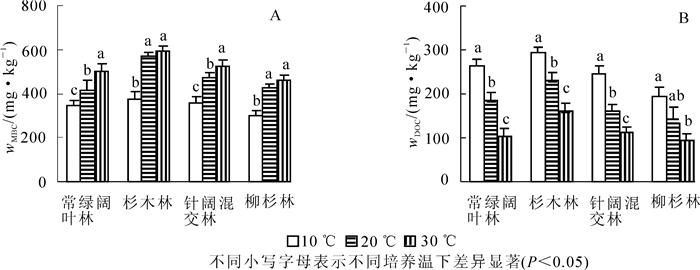-
土壤有机碳分解并释放二氧化碳的过程是土壤重要的生物化学过程,对维持土壤碳库的动态平衡和温室气体的形成起着重要作用[1],并直接关系到养分循环及土壤质量。土壤微生物呼吸是由微生物活动利用有机碳引起的,作为原始驱动力,微生物量碳(MBC)含量的动态和周转与微生物呼吸有着密切关系[2]。微生物呼吸主要以可溶性有机碳(DOC)为碳源,有机碳的解聚和溶解是微生物呼吸的先决条件,有机碳在转化为二氧化碳(CO2)前通常必须先进入溶液中形成DOC[3]。可以说,在土壤微生物呼吸过程中DOC同样起着关键作用[4-5]。温度是影响土壤MBC和DOC含量重要的外部环境因子。大量研究表明:在自然条件下的季节性升温后森林土壤MBC含量显著升高[6-7],而DOC则明显降低[8-9],但也有部分研究得出相反的结果[10-11]。RINNAN等[12]通过对样地实施增温处理时发现在增温到第9年,土壤MBC相比对照地降低,而到第12年却又显示没有明显差异。由于野外土壤生态系统是一个复杂环境体系,且不同研究区域、林分类型[13-14]、处理时间及取样尺度都有可能导致两者对温度的响应方向和程度不同[15]。因此,要进一步理清森林土壤MBC和DOC含量与温度变化的关系机制,还需要结合室内培养实验,排除和控制一些不必要的影响因素。目前,一些学者在这方面进行过一定的探索研究[16-18],但各研究的侧重点有所不同,涵盖的内容还不尽全面。调查结果显示:浙江凤阳山国家级自然保护区原生地带性常绿阔叶林遭受过大规模“判青山”毁林破坏,现存的人工林是由植被破坏后种植的杉木Cunninghamia lanceolata和柳杉Cryptomeria fortunei等针叶树种形成,同时还存在大面积通过自然飞籽传播形成的黄山松Pinus taiwanensis针阔混交林和自然恢复形成的次生常绿阔叶林。上述林分类型在浙江、福建、江西等中国东部中亚热带地区广泛分布,具有一定的区域典型性和代表性。本研究通过室内不同温度培养实验,重点研究微生物呼吸过程中该4种林分土壤MBC和DOC质量分数的动态,明确温度及林分因子对两者的影响程度,并分析因果机理。在当前全球变暖的大背景下,为揭示森林土壤碳循环对气候变化的响应特征及环境驱动机制提供科学参考。
HTML
-
研究区位于浙江省龙泉市凤阳山国家级自然保护区(27°46′~27°58′N, 119°06′~119°15′E),属于武夷山脉东伸的洞宫山系。保护区属亚热带湿润季风气候,雨水充沛,四季分明。年平均气温为12.3 ℃,年均降水量2 325.0 mm[19],雨季集中在4-6月。土壤为黄壤,质地为中壤土,土层厚度为60~80 cm。
-
在研究区分别选取典型的常绿阔叶林(主要树种有木荷Schima superba, 甜槠Castanopsis eyrei,光皮桦Betula luminfera,短尾柯Lithocarpus brevicaudatus),杉木林,针阔混交林(主要树种有黄山松Pinus taiwanensis,中华石楠Photinia beauverdiana,亮叶水青冈Fagus lucida,华东山柳Clethra barbinervis,木荷)与柳杉林为研究对象。4种不同森林的林龄、气候、立地条件及恢复前植被等基本一致,且在生长过程中未受到人为干扰,即4种不同森林是在相同条件下进行演替的。在每种森林内设置3个20 m × 20 m的重复固定样地,共计12个固定样地,对样地进行植物本底调查(表 1)。
森林类型 海拔/m 坡向 坡度/(°) 林龄/a 郁闭度 平均胸径/cm 平均树高/m 常绿阔叶林 1 390 北 30 46 0.85 12.0 12.0 杉木林 1 400 北 28 42 0.80 20.0 14.0 针阔混交林 1 570 北 26 45 0.75 16.0 9.0 柳杉林 1 550 北 28 42 0.90 32.0 15.0 Table 1. Basic information of various stand types
-
于2014年8月,在各个样地内按S型设置4个采集点,取0~20 cm表层土,混合后作为该样地的土壤样品。土样用冷藏箱迅速带回实验室后,剔除石砾、植物残根等。新鲜土样过2 mm筛后直接用于室内培养及活性有机碳的测定;另一部分风干后用于土壤有机碳的测定。
-
将相当于干质量120 g的新鲜土样分别装入高14.3 cm内径10.7 cm的圆柱状塑料瓶中,调整土壤水分含量至80%。瓶口采用组培所用的封口膜进行封口,以减少水分散失,同时在每个瓶的封口膜上扎15个左右细孔,保证空气的自由流通[20]。先将装有土样的塑料瓶在20 ℃中预备培养3 d,然后分别放入10 ℃,20 ℃,30 ℃的3个培养箱中进行暗培养,培养期间通过称量法定期补充水分以保持土壤含水量不变。在培养后的第7天、第14天、第28天、第56天取样,测定土壤微生物量碳、可溶性有机碳质量分数。另外,在培养前还需先测定土样的微生物量碳和可溶性有机碳的初始质量分数。
-
土壤有机碳(SOC)采用硫酸重铬酸钾-外加热法;微生物量碳(MBC)采用氯仿熏蒸浸提法[21],用0.5 mol·L-1硫酸钾浸提熏蒸和未熏蒸土样,m(水):m(土)比为4:1,后在有机碳自动分析仪(TOC-2500,日本)上直接测定浸提液中有机碳质量分数。微生物量碳质量分数=CE/0.45,其中,0.45为转换系数,CE为熏蒸和未熏蒸土样浸提液中的有机碳质量分数的差值;可溶性有机碳(DOC)质量分数=未熏蒸土样浸提液中的有机碳质量分数[22]。
-
采用SPSS 13. 0对数据进行描述统计,然后进行单因素方差分析,并用最小显著差法(LSD)进行多重比较。
1.1. 研究区域概况
1.2. 样地设置
1.3. 采样与分析
1.3.1. 土样采集
1.3.2. 培养实验
1.3.3. 分析方法
1.4. 数据统计与分析
-
由图 1可见:不同森林类型土壤SOC,MBC和DOC质量分数存在着一定的差异。4种森林类型中,土壤SOC和DOC质量分数以柳杉林为最高,MBC则以常绿阔叶林为最高,3种形态有机碳质量分数均以杉木林为最低。常绿阔叶林和柳杉林土壤SOC和DOC质量分数显著高于杉木林(P<0.05),常绿阔叶林土壤MBC质量分数显著高于杉木林(P<0.05)。针阔混交林土壤SOC,MBC和DOC质量分数处于中等水平,土壤SOC和MBC质量分数与其他森林类型之间没有显著性差异(P>0.05),而DOC质量分数显著高于杉木林(P<0.05),但明显低于柳杉林(P<0.05)。
-
在不同温度培养下,土壤MBC质量分数的动态变化并不一致(图 2)。10 ℃条件下,土壤MBC质量分数随着培养时间的延长总体呈下降趋势,前期降幅大,后期降幅小(图 2A);20 ℃条件下,土壤MBC质量分数缓慢下降(图 2B);30 ℃条件下,土壤MBC质量分数先上升后下降,常绿阔叶林于第7天达到峰值,其余3种森林类型于第14天达到峰值(图 2C)。与初始土壤相比,培养56 d后,常绿阔叶林、杉木林、针阔混交林、柳杉林土壤MBC质量分数,在10 ℃培养中,降低了49.3%,48.2%,56.2%和44.8%;在20 ℃培养中,降低了33.3%,27.1%,33.7%和16.2%,在30 ℃培养中则降低了25.6%,20.8%,20.1%和12.6%。
-
由图 3可见:土壤DOC质量分数在不同温度条件下的动态变化也不同。10 ℃条件下,土壤DOC质量分数随培养时间的延长先上升后下降,并保持相对稳定,常绿阔叶林于第7天达到峰值,其余3种森林于第14天达到峰值;20 ℃和30 ℃条件下,土壤DOC质量分数逐渐下降,至28 d后保持相对稳定。在培养过程中,不同时间点森林土壤DOC质量分数大小顺序总体为柳杉林>针阔混交林>常绿阔叶林>杉木林。与初始土壤相比,培养56 d后,常绿阔叶林、杉木林、针阔混交林、柳杉林土壤DOC质量分数,在10 ℃培养中,降低了18.7%,6.5%,2.2%和7.0%;在20 ℃培养中,降低了46.5%,31.1%,31.8%和27.4%,在30 ℃培养中则降低了62.8%,55.0%,61.8%和49.4%。
-
相同森林土壤活性有机碳质量分数在不同温度培养下差异较大(图 4)。在培养过程中,相同时间点的土壤MBC质量分数均表现为30 ℃>20 ℃>10 ℃,而土壤DOC质量分数则表现为10 ℃>20 ℃>30 ℃。培养56 d后,针阔混交林、常绿阔叶林土壤MBC质量分数在3种温度之间均达显著水平(P<0.05),柳杉林和杉木林土壤MBC质量分数在20 ℃与30 ℃之间的差异不显著(P>0.05),但却显著高于10 ℃(P<0.05)(图 4A);针阔混交林、常绿阔叶林和柳杉林土壤DOC质量分数在3种温度之间的差异显著(P<0.05),10 ℃条件下的杉木林土壤DOC质量分数也显著高于30 ℃(P<0.05)(图 4B)。
2.1. 不同森林类型土壤SOC,MBC和DOC质量分数
2.2. 不同温度培养下土壤MBC质量分数的动态
2.3. 不同温度培养下土壤DOC质量分数的动态
2.4. 不同森林土壤活性有机碳质量分数对温度的响应
-
土壤SOC质量分数的大小顺序为柳杉林>常绿阔叶林>针阔混交林>杉木林,其中柳杉林和常绿阔叶林显著高于杉木林。引起这种差异的主要原因是柳杉林和常绿阔叶林的凋落物归还量大(凋落物层厚达10~15 cm),林下灌草相对丰富(柳杉林和常绿阔叶林灌草盖度为40%~50%,杉木林为5%~8%),灌草在生长过程中分泌更多的含碳有机物[23],较厚的凋落物层还能大幅减轻土壤侵蚀强度,有效防止了表土有机碳的流失。另外,杉木造林时,采用全垦种植,且幼龄期采取过抚育间伐、枯木清理等措施,这在一定程度上造成了杉木林地有机碳的丧失[24]。土壤微生物以异养型为主,土壤中可利用碳源是调节其消长的主要因子,因而MBC质量分数与SOC总有机碳关系十分密切,并往往呈很好的正相关[2];DOC主要源于凋落物及土壤腐殖质的分解,根系分泌物和土壤微生物亦是重要来源[25],其较易为微生物所利用,很大程度上也依赖于SOC,一般随SOC质量分数的增加而增加[26]。常绿阔叶林、柳杉林DOC质量分数分别显著高于杉木林。
-
与初始土壤相比,在3种温度条件下培养56 d后,土壤MBC和DOC质量分数下降的幅度总体表现为常绿阔叶林≈针阔混交林>杉木林>柳杉林。凤阳山常绿阔叶林、针阔混交林土壤有机碳比杉木林、柳杉林易分解,稳定性差,能较易转化为活性有机碳[27],在培养过程中,常绿阔叶林、针阔混交林土壤MBC和DOC质量分数下降幅度较大;同时杉木、柳杉等针叶林土壤中的DOC组分中含有较多复杂结构的芳香碳,而中间产物和小分子结构较少[28],生物有效性较低,导致该2种森林类型土壤DOC质量分数下降幅度较少;周运超等[16]认为土壤MBC的变化可能与不同林分微生物本身变化难易有关。同一温度培养过程中,不同森林土壤MBC和DOC质量分数在相同时间点的大小关系基本没有改变,主要原因是DOC溶出量与初始SOC质量分数有关[29],而MBC又受制于DOC。王清奎等[17]也发现室内培养前后常绿阔叶林的MBC和DOC质量分数均高于杉木林。
-
在室内培养中,温度主要通过影响土壤微生物和酶活性对土壤MBC和DOC的产生、分解和转化起调节作用[4, 30]。8月份采样地点的平均温度在19.9 ℃左右[19],将采集的土壤在10 ℃下培养,温度的大幅降低抑制了微生物的生长繁殖,并可能使已适应当时野外环境温度条件所形成的微生物的结构与功能发生紊乱[31],其周转平衡被打破,导致培养前期各林分的MBC急剧下降,微生物对碳源的利用效率也随之降低;同时大量死亡的微生物部分转化为DOC,导致前期不同森林土壤DOC呈上升趋势。GREGORICH等[32]研究表明:土壤微生物残体是DOC的重要来源。室内培养由于缺少凋落物和根系分泌物等碳源的补充,培养后期,微生物呼吸只能依靠土壤中现存有机碳的分解来维持,DOC质量分数随着SOC质量分数下降而不断下降,当碳源不能满足微生物需求时,MBC也会逐渐下降。在20 ℃下,即在基本未改变野外温度条件下,随着微生物利用有机碳的持续进行,碳源供应成为首要限制因子,不同森林土壤MBC和DOC表现出缓慢下降趋势。赵满兴等[33]研究证明:微生物呼吸过程中,DOC中结构相对复杂、难被分解的疏水性和酚类组分比例在增加,使微生物可利用的有效成分减少,这也可能是MBC不断下降的原因。当在30 ℃下,由于温度大幅升高产生的激发效应,增强了微生物的生长繁殖能力,微生物将DOC同化为自身的碳,造成培养前期不同森林土壤MBC呈上升趋势;同时高温导致土壤酶活性提高,使低温下不能分解的有机碳得以分解[34-35],即升温也促进了DOC的析出。但从本研究结果看,还不足以弥补微生物呼吸消耗,前期不同森林土壤DOC快速下降。培养后期,随着DOC来源不足,MBC呈现下降趋势。这与王翠萍[36]、石玲等[37]采用28 ℃恒温培养研究不同土地利用方式下土壤微生物量碳的动态结论类似。
在低于最适温度(35~45 ℃)时,许多模型都预测随温度上升,土壤微生物活性及生长繁殖能力迅速增加,吸收代谢DOC就越强[38]。本研究中同一森林土壤在不同温度下培养,相同测定时间点的MBC质量分数均为高温大于低温,而DOC质量分数均高温小于低温。
3.1. 不同森林对土壤SOC,MBC和DOC质量分数的影响
3.2. 不同森林对土壤MBC和DOC质量分数动态的影响
3.3. 温度对土壤MBC和DOC质量分数动态的影响
-
4种森林类型中,土壤SOC和DOC质量分数以柳杉林为最高,MBC则以常绿阔叶林为最高,3种形态有机碳质量分数均以杉木林为最低。
不同温度培养下土壤MBC和DOC质量分数的动态不同。10 ℃下,土壤MBC质量分数呈前期下降快、后期下降慢的趋势,DOC质量分数则先上升后下降;20 ℃下,土壤MBC和DOC质量分数均呈相对缓慢下降;30 ℃下,土壤MBC质量分数先上升后下降,DOC质量分数前期下降快、后期下降慢。同一森林土壤在不同温度条件下,MBC质量分数大小为30 ℃>20 ℃>10 ℃,DOC质量分数则表现为10 ℃>20 ℃>30 ℃。
同一温度条件下,经过56 d的培养,常绿阔叶林、针阔混交林土壤MBC和DOC质量分数下降幅度均高于杉木林、柳杉林。











 DownLoad:
DownLoad:


